|
Battle of Fort Fisher Fort Fisher Civil War History
Fort Fisher Civil War Battle History, by D.
H. Hill, Jr.*
After Hoke's division was recalled from New Bern [North Carolina] to engage
with Beauregard's army at Drewy's Bluff [Virginia], there was no military operations, except of minor importance, in North
Carolina, until the first attack on Fort Fisher. Colonel Lamb, the heroic defender of the fort, thus describes his works:
"At this time Fort Fisher extended across the peninsula 682 yards, a continuous work, mounting 20 heavy
guns, and having two mortars and four pieces of artillery. The sea face was 1,898 yards in length, consisting of batteries
connected by a heavy curtain and ending in the mount battery 60 feet high, mounting in all twenty-four heavy guns, including
one 170-pound Blakely rifled gun and one 130-pound Armstrong rifled gun. At the extreme end of the point was Buchanan with
four heavy guns."
| Fort Fisher Civil War Battle Map |

|
| Fort Fisher Civil War Battlefield Map |
| Fort Fisher, North Carolina, Civil War |
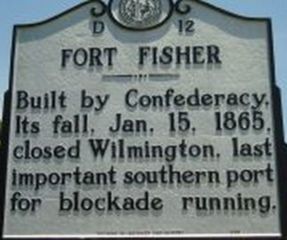
|
| Fort Fisher Civil War Marker |
General Whiting and Colonel Lamb had both expended much labor and ingenuity
in perfecting the defenses of this fort. Wilmington was the port into which the blockade runners were bringing so large a
portion of the supplies necessary for the Confederacy that General Lee said if Fort Fisher fell he could not subsist his army.
This thought nerved Lamb to prolonged resistance.
The garrison, when the Federal fleet arrived on December 20th, consisted
of five companies of the Thirty-six North Carolina (artillery) regiment. General Whiting, in command of the department, entered
the fort as soon as it was threatened. Major Reilly, of the Tenth [North Carolina] regiment (artillery), with two of his companies
also reported there. Colonel Lamb states that the total effective force on December 25th was 1,431, consisting of 921 regulars,
about 450 Junior reserves, and 60 sailors and marines.
The "powder-ship" Louisiana, loaded with 250 tons of powder, was headed
for the fort, and exploded on the night of the 23d. This explosion, however, proved harmless. Then, on the 24th, the [Union]
fleet approached for bombardment. Colonel Lamb thus tells his experience under that fire:
"The fleet consisting of the ironclads, four monitors and forty-five
wooden steam frigates, commenced a terrific bombardment....For five hours a tremendous hail of shot and shell was poured upon
the works with but little effect. At 5:30 the fleet withdrew....Some 10,000 shot and shell were fired by the fleet. The fort
being obliged to husband its ammunition, fired only 672 projectiles....Only 23 men were wounded."
General Porter determined to make a second attempt. So on Christmas
day at 10:30 a.m., the fleet, reinforced by one more monitor and some additional wooden steamers, began another bombardment.
Colonel Lamb tells the result:
| Civil War Fort Fisher Memorial |
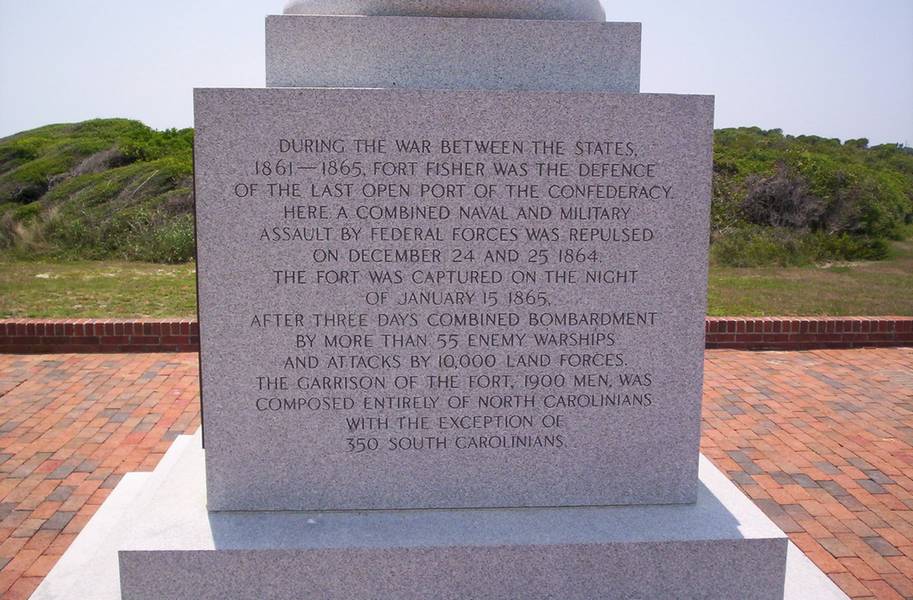
|
| North Carolina and Confederate Fort Fisher |
"At 5:30 p.m., a most terrific enfilading fire against the land face and palisade commenced, unparalleled
in severity. Admiral Porter reported it at 130 shot and shell per minute, more than two every second. The men were required
to protect themselves behind the traverse; the extra men were sent to the bombproofs with orders to rally to the ramparts
as soon as the fire ceased. As soon as this fire commenced, a line of skirmishers advanced toward the works. When the firing
ceased, the guns were manned and opened with grape and canister, and the palisade was manned by two veterans and Junior reserves.
No assault was made. Our casualties for the day, were, killed 5, wounded 33,. In the afternoon both of the 7-inch rifles exploded....five
other guns were disabled by the enemy....There were only 3,600 shot and shell exclusive of grape and shrapnel in the works....Except
when special orders were given the guns were only fired every half hour. In the two days, the frigates Minnesota and Colorado
fired 3,551 shot and shell, almost as many as were in all the batteries of Fort Fisher."
| Fort Fisher Civil War Map |
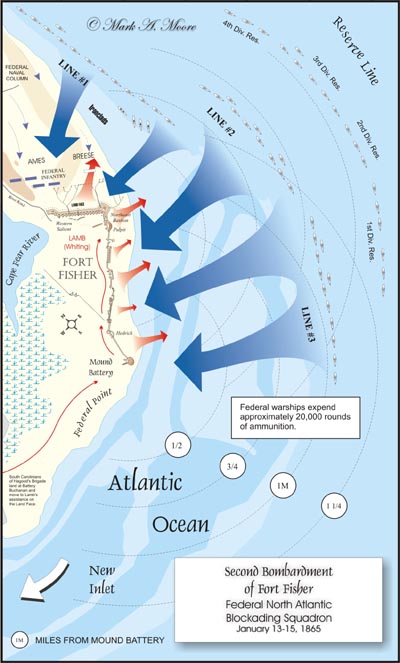
|
| (Map) U.S. Naval Bombardment of Fort Fisher, NC |
With this second experience, General Butler retired, and the the fort
had
a respite until January. The expedition had been fitted out elaborately and was unusually strong.
Captain Selfridge, who commanded
one of Butler's ships, says:
"The navy department was able to concentrate
before Fort Fisher a larger
force than had ever before assembled under one command in the history of the American navy--a total
of nearly sixty vessels."
The total number of guns and howitzers,
according to the computation
of the editors of "Battles and Leaders," was over 600, and the total weight of projectiles at a
single discharge of all the
guns was over 22 tons. The retirement of this great armament without accomplishing anything was
a great disappointment to
the Federal authorities. Captain Selfridge says: "Words cannot express the bitter feeling and
chagrin of the navy."
| Battle of Fort Fisher Map |
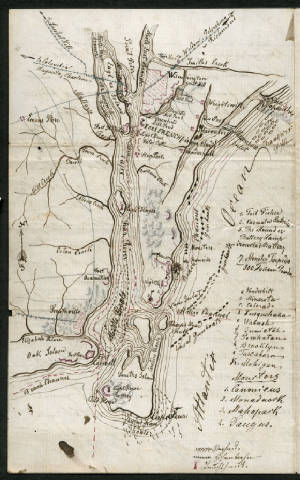
|
| Civil War Fort Fisher Battle Map |
| Civil War Fort Fisher Map |
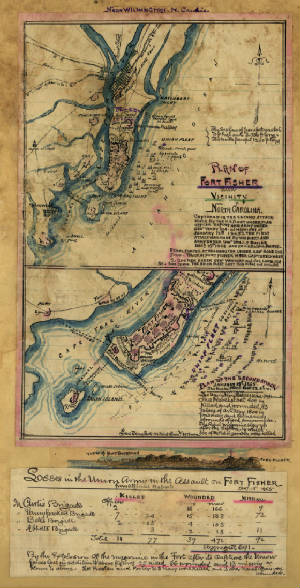
|
| Fort Fisher Civil War Map |
| Battle of Fort Fisher, 1865 |
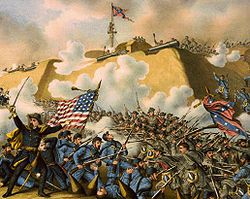
|
| Depiction of Fort Fisher Battle |
When it became evident to the Confederate
government that Fisher was to
be attacked, General Hoke's division was ordered to its relief, reaching Wilmington on the 24th
of December, and the advanced
regiments arrived at Fisher on the same day. Butler, having landed a force on the ocean side, the
Seventeenth North Carolina
was withdrawn from the fort on the 25th and ordered to attack.
(Left) Period art showing the struggle between two determined armies engaged in a conflict that had already
endured nearly four years. Once Fort Fisher fell to the Federals in January, the war would end three months later in
April 1865.
As General Butler withdrew his men, only a skirmish occurred.
General Bragg was in chief command in the State [North Carolina]. Evidently not expecting a second
attack, he withdrew Hoke
from Sugar Loaf, and the division went into camp near Wilmington, sixteen miles from Fisher.
But General Terry, with about the same force
that General Butler had commanded,
except that it was reinforced by two negro brigades, was ordered to retrieve the first reverse.
On the 14th of January, Terry
landed 8,500 men without opposition, and that night, moving across the peninsula, constructed a
line of field works from the
ocean to Cape Fear River, thereby cutting off all land communication between the fort and General
Bragg's command.
No effort of any importance
seems to have been made by the commanding
general [Bragg] to assist the doomed fort.
| Civil War Battle of Fort Fisher Monument |
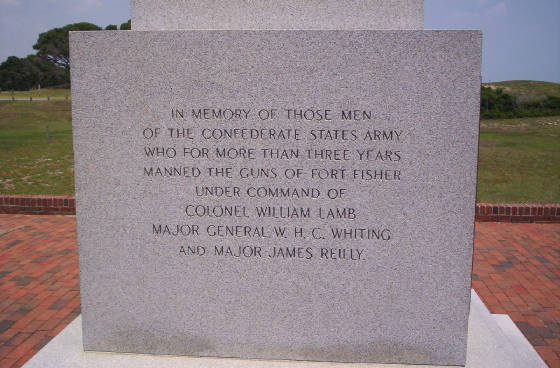
|
| Fort Fisher, North Carolina |
| 2nd Battle of Fort Fisher History |
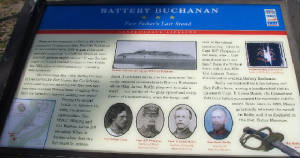
|
| Fort Fisher Battle History |
After the first bombardment, five
companies of the Thirty-six regiment (artillery)
returned from Georgia and took their old place in the garrison. The total force there, after the
return of these men, was
about 1,900.
"All day and all night on the 13th and 14th
[of January]," says Colonel
Lamb, "the fleet kept up a ceaseless and terrific bombardment....It was impossible to repair damage
at night. No meals could
be prepared for the exhausted garrison; the dead could not be buried without new casualties. Fully
200 had been killed during
these two days, and only three or four of the land guns remained serviceable."
Then the land forces approached nearer and
nearer by pits and shelter, and
Colonel Lamb, and all their officers and men fight for the important fort; frequently did they
signal for the aid they sorely
needed. General Whiting and Colonel Lamb were both severely wounded. On the 15th, after exhausting
every energy, the fort
was surrendered. The Federal loss is stated at 1,445. The garrison lost about 500. Few more gallant
defenses against such
odds are recorded. General Whiting died shortly after in a Northern prison.
| Fort Fisher North Carolina Map |
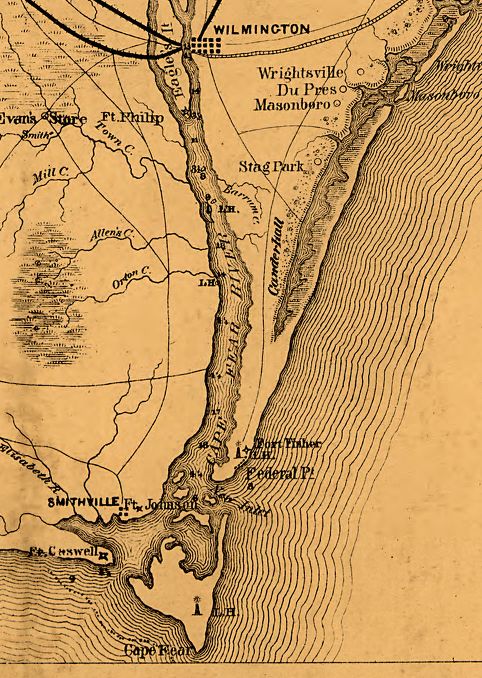
|
| Map of Fort Fisher: Guardian of Wilmington |
(Map) Eastern portion of the military department
of North Carolina compiled
from the best and latest authorities in the Engineer Bureau, War Department, May 1862.
*D. H. Hill, Jr., son of Confederate Lieutenant General Daniel Harvey Hill,
Sr., was the author of Confederate Military History Of North Carolina:
North Carolina In The Civil War, 1861-1865 -- which is a welcome addition to the North Carolina Civil War buff. North
Carolina native Daniel Harvey Hill, Sr. -- commonly referred to as D. H. Hill -- was one of only two lieutenant
generals from the Tar Heel State. (Lieutenant general was the second highest rank
in the Confederate Army.) Hill was also brother-in-law to the renowned "Stonewall" Jackson.
**In 1935 the General Assembly authorized the establishment of the official
North Carolina Highway Marker Program, which is also the only authoritative Civil War Marker Program to represent
the State of North Carolina. Its mission is to educate and to preserve the heritage and history of North Carolina through
historical and interpretive markers in coastal, piedmont, and mountain regions. Its photos and pictures of
Civil War markers are also always free to the public and are the only markers online that officially represent
the Civil War in North Carolina. As a disabled military veteran with the loss of use of both legs and who can no longer visit
the Civil War markers, I applaud the NC historical marker program for its preservation
efforts and for allowing us the opportunity to freely educate classroom students of Fort Fisher in the Civil
War.
(Sources
and related reading below.)
Recommended
Reading: Confederate Goliath: The Battle of Fort
Fisher. From Publishers Weekly: Late in the Civil War, Wilmington,
N.C.,
was the sole remaining seaport supplying Lee's army at Petersburg,
Va., with rations and munitions. In this dramatic account, Gragg
describes the two-phase
campaign by which Union forces captured the fort that guarded Wilmington and the subsequent occupation
of the city itself--a
victory that virtually doomed the Confederacy. In the initial phase in December 1864, General Ben
Butler and Admiral David
Porter directed an unsuccessful amphibious assault against Fort
Fisher that included the war's heaviest artillery
bombardment. Continued
below…
The second
try in January '65 brought General Alfred Terry's 9000-man army against 1500 ill-equipped defenders,
climaxing in a bloody
hand-to-hand struggle inside the bastion and an overwhelming Union victory. Although historians
tend to downplay the event,
it was nevertheless as strategically decisive as the earlier fall of either Vicksburg or Atlanta.
Gragg
has done a fine job in restoring this important campaign to public attention. Includes numerous
photos.
Advance
to:
Recommended
Reading: Hurricane of Fire: The Union Assault on Fort
Fisher (Hardcover). Review: In December 1864 and January 1865, Federal forces launched
the greatest amphibious
assault the world had yet seen on the Confederate stronghold of Fort
Fisher, near Wilmington,
North
Carolina. This was the last seaport available to the South--all of the
others had been effectively
shut down by the Union's tight naval blockade. The initial attack
was a disaster; Fort Fisher,
built
mainly out of beach sand, appeared almost impregnable against a heavy naval bombardment. When troops
finally landed, they
were quickly repelled. Continued below…
A second attempt
succeeded and arguably helped deliver one of the death blows to a quickly fading Confederacy. Hurricane
of Fire is a work
of original scholarship, ably complementing Rod Gragg's Confederate Goliath, and the first book
to take a full account of
the navy's important supporting role in the assault.
Recommended
Reading: The Wilmington Campaign and the Battle
for
Fort Fisher, by Mark A. Moore. Description:
Full campaign and battle history of the largest combined operation in U.S.
military history prior to World War II. By late 1864, Wilmington
was the last major Confederate blockade-running seaport open to the outside world. The final battle
for the port city's protector--Fort Fisher--culminated
in the largest naval bombardment of the American Civil War, and one of the worst hand-to-hand engagements
in four years of
bloody fighting. Continued below…
Copious illustrations,
including 54 original maps drawn by the author. Fresh new analysis on the fall of Fort Fisher,
with a fascinating comparison
to Russian defenses at Sebastopol during the Crimean War. “A
tour de force. Moore's Fort Fisher-Wilmington Campaign is
the best publication of this
character that I have seen in more than 50 years.” -- Edwin C. Bearss, Chief Historian Emeritus,
National Park Service
Recommended
Reading: The Wilmington Campaign:
Last Departing Rays of Hope.
Description: While prior books on the battle to capture
Wilmington,
North Carolina, have focused solely on the epic struggles for
Fort Fisher, in
many respects this was just
the beginning of the campaign. In addition to complete coverage (with significant new information)
of both battles for Fort Fisher, "The Wilmington
Campaign" includes the first
detailed examination of the attack and defense of Fort
Anderson. It also features blow-by-blow accounts of the defense
of the Sugar Loaf Line
and of the operations of Federal warships on the Cape Fear River.
This masterpiece of military
history proves yet again that there is still much to be learned about the American Civil War. Continued
below…
"The Wilmington
Campaign is a splendid achievement. This gripping chronicle of the five-weeks' campaign up the
Cape Fear River
adds a crucial dimension
to our understanding of the Confederacy's collapse." -James McPherson, Pulitzer Prize-winning author
of Battle Cry of Freedom
Recommended
Reading: Rebel Gibraltar: Fort Fisher and Wilmington, C.S.A. Description: Even before the rest of North Carolina joined
her sister states in secession,
the people of the Lower Cape Fear were filled with enthusiasm for the Southern Cause - so much
so that they actually seized
Forts Johnston and Caswell, at the mouth of the Cape Fear River, weeks before the first shots were
fired at Fort Sumter. When
the state finally did secede, Wilmington became the most important port city of the Confederacy,
keeping Robert E. Lee
supplied with the munitions and supplies he needed to fight the war against the North. Continued
below…
Dedicated soldiers
like William Lamb and W.H.C. Whiting turned the sandy beaches of southern New Hanover and Brunswick
Counties into a series
of fortresses that kept the Union
navy at bay for four years. The mighty Fort
Fisher
and a series of smaller forts offered safe haven for daring blockade runners that brought in the
Confederacy's much-needed
supplies. In the process, they turned the quiet port
of Wilmington into a boomtown. In this book that was fifteen
years in the making, James
L. Walker, Jr. has chronicled the story of the Lower Cape Fear and the forts and men that guarded
it during America's bloodiest conflict, from the early days of the war to
the fall of Wilmington in February 1865.
Recommended
Reading: The
Civil War in the Carolinas (Hardcover). Description:
Dan Morrill relates the
experience of two quite different states bound together in the defense of the Confederacy, using
letters, diaries, memoirs,
and reports. He shows how the innovative operations
of the Union army and navy
along the coast and in the bays and rivers of the Carolinas affected
the general course of
the war as well as the daily lives of all Carolinians. He demonstrates the "total war" for
North Carolina's vital coastal railroads and ports. In
the latter
part of the war, he describes how Sherman's
operation cut
out the heart of the last stronghold of the South. Continued below...
The author
offers fascinating sketches of major and minor personalities, including the new president and state
governors, Generals Lee,
Beauregard, Pickett, Sherman, D.H. Hill, and Joseph E. Johnston. Rebels and abolitionists, pacifists
and unionists, slaves
and freed men and women, all influential, all placed in their context with clear-eyed precision.
If he were wielding a needle
instead of a pen, his tapestry would offer us a complete picture of a people at war. Midwest Book Review: The Civil War in the Carolinas by civil
war expert and historian Dan
Morrill (History Department, University of North Carolina at Charlotte, and Director of the Charlotte-Mecklenburg
Historical
Society) is a dramatically presented and extensively researched survey and analysis of the impact
the American Civil War had
upon the states of North Carolina and South Carolina, and the people who called these states their
home. A meticulous, scholarly,
and thoroughly engaging examination of the details of history and the sweeping change that the
war wrought for everyone, The
Civil War In The Carolinas is a welcome and informative addition to American Civil War Studies
reference collections.
|

